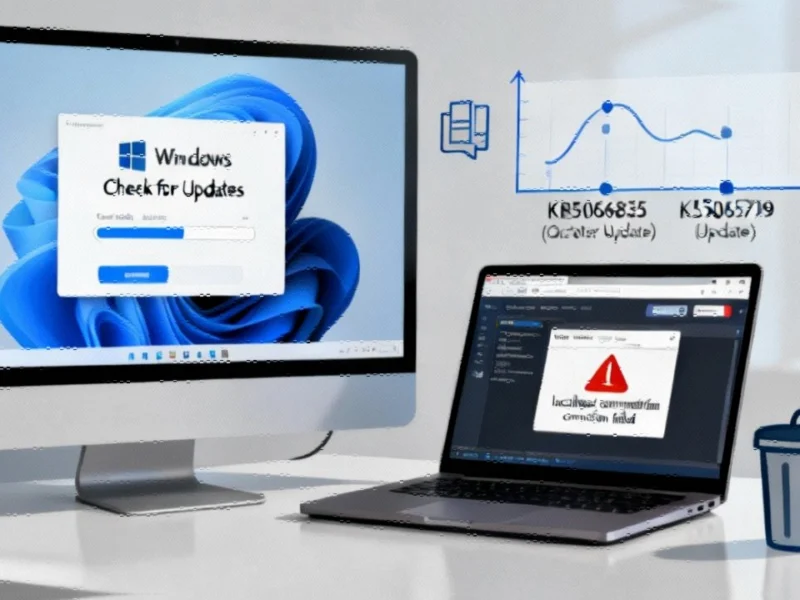Critical update conflicts disrupt web services
Microsoft has confirmed that recent Windows 11 updates are causing widespread failures for IIS (Internet Information Services) websites, forcing the company to issue emergency guidance for affected systems. The problematic updates—KB5066835 for Windows 11 24H2 and 25H2, along with KB5065789—have created conflicts within the HTTP stack that prevent proper website loading and authentication processes. This development follows similar infrastructure disruptions recently affecting enterprise environments, highlighting the ongoing challenges in maintaining system stability amid rapid update cycles.
The core issue stems from the HTTP.sys driver, which manages web server connections in Windows environments. After installing updates released on or after September 29, 2025, server-side applications relying on this critical component began experiencing connection problems. Administrators report that localhost loopbacks and various IIS-based authentication mechanisms are failing, with browsers displaying “ERR_CONNECTION_RESET” errors instead of loading websites. Microsoft acknowledges the problem may not manifest uniformly across all systems, noting that “device internet connectivity, timing of update installation, and device restarts” create variable conditions that determine whether the bug appears.
Technical breakdown of the HTTP.sys conflict
The HTTP.sys driver serves as the foundational web server architecture for IIS, handling all incoming HTTP requests and response caching. The recent updates appear to have introduced changes to how this driver manages connection security contexts, particularly affecting local authentication processes. This disruption comes at a time when cybersecurity threats are evolving rapidly, making stable web server infrastructure more critical than ever for organizational security.
Microsoft’s investigation reveals the problem specifically impacts:
- Websites hosted on localhost addresses
- IIS websites using Windows Authentication
- Applications relying on HTTP.sys for request processing
- Development environments testing web applications locally
Immediate workaround and enterprise impact
While Microsoft develops a permanent solution, the company has directed IT administrators to implement a Known Issue Rollback through Group Policy. The specific policy—”Windows 11 24H2, Windows 11 25H2 and Windows Server 2025 KB5066835 251015_22001 Known Issue Rollback”—can be deployed through Computer Configuration > Administrative Templates in Group Policy Editor. This temporary measure reverses the problematic code changes while maintaining other security updates from the patch. The timing of these web service disruptions coincides with broader economic concerns about technology infrastructure stability, as organizations increasingly depend on reliable web services for operations.
Enterprise environments face significant operational challenges from these IIS failures. Development teams cannot test applications locally, quality assurance processes are interrupted, and internal web applications become inaccessible. The situation underscores the importance of comprehensive testing environments that mirror production systems, a practice emphasized by innovative approaches to infrastructure management emerging outside traditional tech hubs.
Broader implications for update management
This incident represents the second major update-related issue Microsoft has addressed recently, following the resolution of third-party driver problems that previously blocked Windows 11 24H2 upgrades. The pattern highlights the increasing complexity of maintaining compatibility across countless hardware and software configurations. As AI-enhanced platforms become more integrated into business operations, the stability of underlying infrastructure grows increasingly critical.
System administrators should approach update deployment with heightened caution, particularly for production web servers. Recommended practices include:
- Implementing staged rollouts across test environments first
- Maintaining comprehensive backup and rollback procedures
- Monitoring Microsoft’s Windows Health dashboard for emerging issues
- Establishing communication channels with development teams about potential impacts
Future outlook and resolution timeline
Microsoft has not provided a specific timeline for a permanent fix but indicates work is underway. The company’s use of Known Issue Rollbacks demonstrates a more responsive approach to update problems, allowing temporary resolutions while comprehensive solutions are developed. This methodology reflects a broader industry trend toward managing complex systems through adaptive strategies rather than attempting perfect initial deployments.
The incident also highlights the delicate balance between security updates and system stability. As Microsoft intensifies its focus on security following increasing threats, the potential for compatibility issues grows. Organizations must weigh the benefits of immediate patching against operational stability, particularly for critical infrastructure components like web servers. This challenge mirrors complexities seen in other sophisticated systems where multiple components must work in harmony to achieve reliable performance.
Administrators experiencing these IIS issues should implement Microsoft’s recommended Group Policy workaround immediately and monitor official channels for updates about a permanent resolution. The company’s health dashboard provides the most current information about the investigation and repair progress.
Based on reporting by {‘uri’: ‘neowin.net’, ‘dataType’: ‘news’, ‘title’: ‘Neowin’, ‘description’: ‘News, Reviews & Betas which includes large community peer support’, ‘location’: {‘type’: ‘place’, ‘geoNamesId’: ‘5006059’, ‘label’: {‘eng’: ‘Plymouth, Michigan’}, ‘population’: 9132, ‘lat’: 42.37143, ‘long’: -83.47021, ‘country’: {‘type’: ‘country’, ‘geoNamesId’: ‘6252001’, ‘label’: {‘eng’: ‘United States’}, ‘population’: 310232863, ‘lat’: 39.76, ‘long’: -98.5, ‘area’: 9629091, ‘continent’: ‘Noth America’}}, ‘locationValidated’: False, ‘ranking’: {‘importanceRank’: 259357, ‘alexaGlobalRank’: 14895, ‘alexaCountryRank’: 14478}}. This article aggregates information from publicly available sources. All trademarks and copyrights belong to their respective owners.



